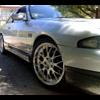Announcements
-
Similar Content
-
Latest Posts
-
By Chocolate Cheesecake. · Posted
Thanks to @V35_Paul there is an oem stereo available on gumtree, but the fascia is slightly different. It has a flip up screen as opposed to my pop up screen. Am I able to disconnect the radio/cd player from the fascia to use it on mine? -
By Dose Pipe Sutututu · Posted
Had to google what a quart is lol.. so rough as guts a litre. That's a bit excessive, also what oil weight are you running? The whole steam cleaning idea isn't too far fetched either. Maybe as you suggested, turn off the WMI (assuming your Kebabtech pulls timing, boost, etc.) and run it for a bit and see if there are any noticeable changes in spark plug colouring. -
By joshuaho96 · Posted
Pretty simple question. I was about to put the transmission back in and thought I pretty much had it lined up when I noticed it seems like the pressure plate isn't flat. I was pretty careful when undoing the bolts both during initial disassembly for cleaning and when torquing them up for installation so this is pretty discouraging. I'm not sure if I accidentally bumped the pressure plate with the input shaft and bent it somehow or if it just showed up this way. Is it possible that there's just something obvious I'm not doing correctly? I'm pretty sure I was extremely careful to make sure the friction discs were seated correctly in the hub, everything lined up, flywheel torqued according to sequence, the little springs all sitting correctly in their seats, etc. What's the play here? Do I jump straight to a new pressure plate? -
OK. I can see that being the case. But if you live in the land of "only switching between 4.08, 4.11, 4.36" like most Skyliners, then you never encounter it. Now I perhaps understand why the crownwheel is thicker on some of the smaller numerical ratio diffs. The two stubs being the same (unequal) lengths and just swapped side to side between the different cases is a new one to me. I'm hating Nissan R200s more than ever now.
-
Reason I say this is I have seen broken ones, in drift, drag and even behind a stock Z. I do appreciate most of the time its the synchro's that go. Trouble with quoting HP is it doesn't really say how strong the box is. I've not seen many CD00X box's make it past a mid 9(150mph) I have seen about a stock R33 RB25 box's run a 9 too, they all go boom at some point though. Another clue is they make gearsets for CD00X box's too, wouldn't be a market if they didn't break or have a limit people are going past. I totally agree it is a strong box, just have to weigh up the true total cost of the conversion vs rebuilding with a good gearset.
-






Recommended Posts
Create an account or sign in to comment
You need to be a member in order to leave a comment
Create an account
Sign up for a new account in our community. It's easy!
Register a new accountSign in
Already have an account? Sign in here.
Sign In Now